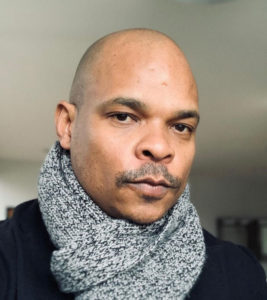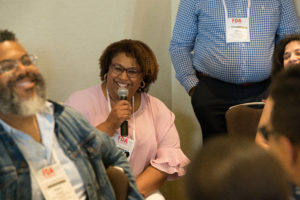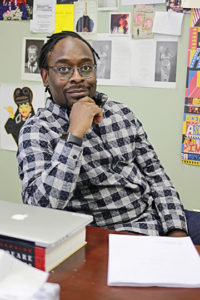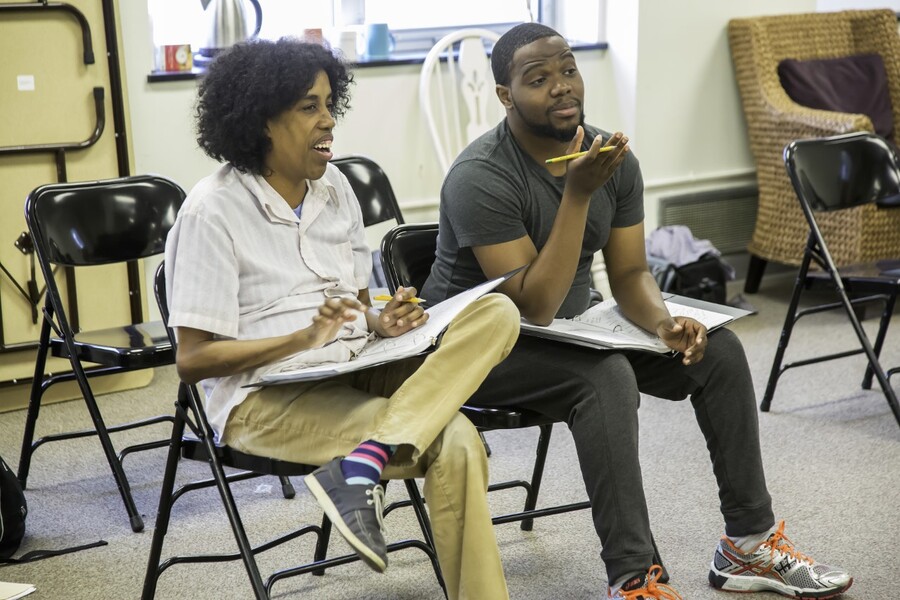Goodman Theatre associate producer Ken-Matt Martin painted a familiar picture for me: It’s the first day meet-and-greet for a production where a theatre is producing a show written by a Black playwright, directed by a Black director, and featuring a Black cast. During the meet-and-greet, as those involved introduce themselves to the theatre’s employees, those in the production find themselves encircled by a sea of white faces.
Well meaning as those overwhelmingly white staffs may be, the persistent recurrence of scenes like this has led Martin to state frankly that he thinks it’s doing more harm than good for America’s predominantly white-run, white-staffed theatres to keep trying to produce more plays by people of color, directed by people of color, and with people of color in the cast, while that opening-day disparity—reflecting a lack of diversity in theatres’ administration, middle management, and staff—continues, season after season, show after show.
Even before the theatre’s current moment of anti-racist reckoning, including the work of the We See You White American Theatre (WSYWAT) collective, it had become increasingly obvious how completely out of touch it is to program all-white seasons with all-white casts, or even lightly tokenized versions of same. Why, then, has this self-awareness not spread throughout the theatrical ecosystem—specifically to staffs and boardrooms? This is a question that led to a section of the WSYWAT’s recent 29-page list of demands covering employment, mandating “an immediate end to oppressive hiring practices.” Steps toward this goal include a commitment to a truly diverse pool of BIPOC candidates throughout all levels of theatre staff, transparent hiring practices and searches for same, and the building of relationships with BIPOC artists in a theatre’s local area.
And then the document raises the bar: It demands that BIPOC theatremakers comprise the majority of leadership positions, middle management positions (including production department heads and company managers), and literary departments. Though current statistics are hard to come by, the field is currently quite far from this percentage. That means that this change will be a heavy lift, but organizers say it’s not only worth it—it’s urgent and long overdue.
“I have found myself, I would say in 90, 95 percent of the meetings that I’m in, being the only Black person in the conversation, if not the only person of color period,” said Martin, who has also previously worked with Williamstown Theatre Festival as producing director. “I certainly think that now that the industry is in this moment of reckoning—and even before this moment of reckoning—as they’ve been trying to work with more people of color on their stages, if the leadership and the staff don’t reflect that, I don’t know that we’re going to actually get anywhere.”
Rudy Ramirez, associate artistic director of the Vortex in Austin, knows that a shake-up like the one recommended by the WSYWAT demands would ruffle a lot of feathers. But it’s the kind of drastic personnel shift that is needed for the few BIPOC artists who work in the theatre, and are typically seen and treated more as guests than as owners. One particular challenge Ramirez spoke to me about was a conflicting set of expectations for BIPOC theatremakers: They are expected to have a complete knowledge of the mainstream white theatre world and language, while also operating under a (typically) unspoken assumption that they can or will only work on material that reflects their own personal heritage. Possibly worse: presumptions about what that “heritage” is supposed to mean.
“The thing that I don’t think is spoken about enough is the ways in which, when it’s one of us, we are often called on to speak to experiences that we have absolutely no knowledge of,” Ramirez said. “Being the one Latinx person in the room is like, ‘Tell us what it’s like to be Cuban.’” Ramirez, who is Mexican American, says, “I’m like, I have seen Cuban things, but there’s a lot that I can’t speak to.”
He recalled working on a show about Mexican American characters with a white playwright and white dramaturg in which a song they had planned on using was cut because it was perceived to be a “Puerto Rican” song—even though Ramirez says he distinctly remembered growing up hearing that song in his Mexican American community. It’s situations like these within predominantly white institutions (PWIs), where the nuances of culture and heritage can get lost, that Ramirez would like to see rectified by the changes demanded by WSYWAT.
“This will allow these PWIs to realize that no racial community is monolithic,” Ramirez said. “You’re not going to get one single right answer for how to portray a Black community, a Latinx community, an Asian community. There’s not a consensus anywhere about how we should be portrayed, and if you tick off all those boxes, you’re done and no one will be mad at you. Having a community, not just a single representative but a real community of artists of color, allows you to understand that variance and depth, and that you are not here to give the definitive story, you are here to be part of a conversation.”
How to create this kind of community at every theatre? Among WSYWAT’s demands is a call for the elimination of the “Rooney Rule”—an NFL standard that requires teams to interview at least one “minority” candidate for top-level positions—when hiring for theatre positions. The rule itself is much maligned, since requiring a team to bring in one non-white man doesn’t actually lead to diversity or even progress. As one coach told The Washington Post earlier this year, with the NFL’s head coaching vacancies filled by all but one white man, people think he must be dumb for even going in for top-tier interviews: “I’ve felt that, being there as a token, where you know you have no shot.” WSYWAT’s demands go well beyond that, aiming for a true diversification of the hiring pool rather than a system that easily plays into tokenization.
“You look at the data and you tell us if you believe that this is ethical.”
One group already attacking this disparity at the Broadway level is the Black Theatre Coalition (BTC), founded this year by T. Oliver Reid, Warren Adams, and Reginald “Reggie” Van Lee to increase the work opportunities for Black theatre professionals by at least 500 percent by 2030. Their goals have grown from initial conversations about creating a performance series with all-Black casts and creatives (a goal that’s still in their mission) to realizing the many other places where Black artists haven’t had sufficient opportunities.
BTC began charting the work of Black professionals in the Broadway ecosystem—not only onstage, backstage, and on the design team, but throughout the process, including casting, public relations, general management, and marketing—over the 154 years since The Black Crook became the first Broadway musical in 1866. Analyzing 3,002 musicals and 8,326 plays, BTC notes in their research that there have only been two Black lead producers of a musical (Ken Harper with The Wiz in the ’70s, then two years ago with Berry Gordy and Motown). The trickle-down effect of that statistic, they found, was bleak: Their research showed that there have been only 10 Black directors of a musical, 11 Black directors of a play, and 17 Black choreographers, in the history of Broadway as we know it.

“So if you’re looking at emerging Black directors in the American theatre,” Adams said, speaking specifically about directors of a musical, “what the American theatre is saying to those Black directors is that you have a .33 percent chance of ever being hired.”
The numbers only became more dismal as they tallied how many Black theatremakers worked as writers, composers, scenic designers, lighting designers, costume designers, sound designers, video designers, music contractors, musical directors, arrangers, orchestrators, hair/wig/makeup artists, casting directors, general management, stage management, company management, public relations, and marketing and advertising workers. The counts in each of these categories ranged from 0 to 5 per category, they found. Bringing these numbers to the attention of those they’ve been meeting with, both on Broadway and beyond, has yielded positive results, according to Adams.
“We’re saying, here’s the information,” Adams said. “You look at the data and you tell us if you believe that this is ethical. Then it’s the decision of whomever we’re talking to.”
BTC’s current partnerships (or “accomplices”) include Thomas Schumacher (president of Disney Theatrical Group), Rick Miramontez (president of DKC/O&M public relations), MCC Theater, Classic Stage Company, the Alliance Theatre in Atlanta, and Arena Stage in Washington, D.C. An initial press release from BTC also noted that they will be working with the Broadway revival of Company to implement 10 paid apprenticeship positions whenever the postponed production heads back into rehearsals. This model, which places paid Black artists throughout the entire ecosystem of a production, is one they hope to implement on every Broadway show and beyond.
“I think there will be a lot of people saying, ‘Oh, but where do I find Black creatives?’” said Adams. “And the thing I always want to say is, ‘If you go to the design schools, they’re there, but after graduation, there are no opportunities for them.’ What we’re doing is alienating more from even going into that, because why would you go study to be a lighting designer if you’re Black, and if in the history of Broadway there’s only ever been two?”
BTC is working with historically Black colleges and universities, as well as predominantly white colleges and universities, to find young Black professionals and start making connections with them. A goal for BTC is to establish paid internships, apprenticeships, and fellowships—actual paid internships that go beyond a $200 stipend and a Metro card, and include a salary and benefits—by working with theatres to determine what they can put toward this program, then turning to BTC’s partners and donors to fill in any gaps.
“The problem with those internships is that a lot of these folks are spending a majority of their time at these institutions, but then they have to run and go do their night job of bartending,” Warren explained, emphasizing the effort to put these fellowships in places where the work will be with those at the highest level of the business, not running around getting coffee or answering the phone. “Our goal is to see, between now and 2030, how many of those full, complete ecosystems can be created. In addition to that, this is not just about identifying people, putting up money, and they’re on their own. We are going to make sure that during their year of being fellows, the industry is meeting them, and they’re all meeting together in groups on a quarterly basis.”
“But when we revisit those organizations 12 months from now, my question is: What changes would have been implemented at the actionable level? Not just the words.”
A system like this might have changed the industry experience of Paige Hernandez, the newly appointed associate artistic director at Baltimore’s Everyman Theatre. Hernandez recalled working for “$200 and pizza” early in her career, lamenting that some theatres never made the effort to keep in touch with her as she continued her career. She’s come to believe that once BIPOC artists are in the door, theatres must not only be more open and receptive to their suggestions; they should also strive to forge long-lasting relationships with BIPOC artists they meet at a young age.

“The potential for someone who has extreme promise is always there,” Hernandez said. “Theatres really need to look at someone who they’ve recruited as young as high school and middle school and really see it through so that they are a part of that young person’s life for the entirety of their career.”
Theatres should make this investment in the careers of BIPOC theatremakers, Ramirez pointed out, because they recognize the absolute necessity of it, not simply because it’s fashionable. And they shouldn’t limit that investment in artists of color only to pieces related to their race or ethnicity.
“The person who is doing the community outreach for the show about a Latinx community—why aren’t they also doing it for the white community shows?” Ramirez posited. “Why do you think that they couldn’t, or why do you think that they don’t need to? There’s a lot of very intense interrogation that needs to happen.”
Ramirez also echoed the need for theatres to truly commit to recruiting artists of color. He noted that he didn’t see a real commitment to that goal in Austin-area theatres until funding was made contingent upon it. Even then, the pressure from funders and boards was aimed at diversifying the pool of playwrights, actors, and directors, allowing companies to overlook the homogeneity of their administration, tech, and design pools. As part of BTC’s mission, the coalition is creating a national database of Black theatre professionals to serve as a resource. Hernandez also encourages a similar embracing of technology, and the need for more of a national theatrical community of BIPOC theatre workers. Similar databases—like ones for BIPOC theatre designers and technicians and underrepresented theatre critics— have begun to pop up over the years with the hope of encouraging organizations to start enacting this change, quit claiming a lack of options, and stop gesturing toward change through statements.
“What we were seeing was an outpouring of messaging from theatre organizations: ‘We vow to do this,’ ‘We promise,’ ‘Our mission,’” Adams said. “All very strong words, and it was very encouraging to see. But when we revisit those organizations 12 months from now, my question is: What changes would have been implemented at the actionable level? Not just the words. Do you have mentorship programs implemented so that we have our next generation of designers, our next generation of executives, our next generation of management? If, in 12 months from when you put out that statement, nothing has changed in your organization, then what it really means is that you are only saying that to put a Band-Aid on it. You’re not really interested in actual, actionable change.”
As the leader of the Repertory Theatre of St. Louis, artistic director Hana Sharif emphasized to me that, more than mentorship, what theatres need to improve upon is the persistent absence of access and agency that BIPOC theatremakers have experienced throughout their careers. BIPOC workers’ journey toward leadership positions is especially difficult, Sharif explained, because the system was not set up to support BIPOC artists. In a theatre ecosystem historically run and controlled by white men, prime access to opportunities has been passed along that same demographic line.

“The fact that I’m one of the first African American women to run a major LORT theatre is insane,” Sharif said. “There are so many incredibly talented Black women producers that predate me who created the very ground on which I stand, who had all of the talent, who lent their ingenuity to make the men they worked for look amazing and to help build their brands. There are plenty of women who should have had the opportunity to compete for these jobs.”
What’s more, Sharif continued, many programs heralded as innovative or groundbreaking when a large, predominantly white theatre implements them were actually copied from or inspired by programs built at small, culturally specific theatres.
“Certainly those theatres have underwritten community and audience engagement programs that then larger regional theatres copy, mimic, and receive extraordinary funding for,” Sharif said. The Rep has been no exception, receiving “extraordinary funding” for programming “directly modeled off the ingenuity of BIPOC artists working in ethnically specific theatres with much smaller budgets.”
“Until more people are willing to give up power within these white institutions, I don’t think this will ever actually change.”
This discrepancy has led many, including the Vortex’s Ramirez, to wonder what it would look like for predominantly white institutions, in their purported effort to foster more diversity, to start asking how they can help beyond simply bringing people into their own space. An investment in theatres of color that are already serving communities of color can also open doors to diversity beyond the BIPOC label, and give these smaller theatres room to continue to deeply explore diversity of gender, sexuality, and ability through their work.
“I wonder what it would mean to be called upon to foster companies of color from the ground up, many of which are already in their cities,” Ramirez said. “What would it mean to be looking to companies that are invested in a non-white community, specifically saying, ‘We are exploring the diversity within that community through our work. We are not trying to tell one kind of Black story, Latinx story, we are telling all of them.’”
It’s this kind of ground-up work that beckons to Martin. When I asked if he would like to run a theatre like the Goodman one day, he said that, while that used to be a goal of his, and that’s the trajectory he had likely once been on, his dream now is to eventually go back down South to make theatre (he’s originally from Little Rock, Ark.). As the founder of Iowa’s Pyramid Theatre Company, Martin imagines doing something similar in different Southern cities, spending a few years in each to help seed new theatre companies and set them up for success before moving on.
“Having seen what I’ve seen, experienced what I’ve experienced, and learned what I’ve learned,” Martin said, “I’m more interested in what it looks like to make theatre that is in and of the communities it exists within, and being part of a collaborative process to make that happen.”
Looking at theatre organizations as they’re currently constituted, though, Martin notes that the kind of full-ecosystem change demanded by the WSYWAT document is going to be difficult.
“I think it’s about many inside of these organizations having not had a chance to come to terms with, in order for this to change, it’s going to require some sacrifice,” said Martin. “Until more people are willing to give up power within these white institutions, I don’t think this will ever actually change.”
As one of the co-artistic directors within a new leadership-sharing structure at Philadelphia’s Wilma Theater, playwright and performer James Ijames is already seeing how a change in power can open theatres to new lived experiences. Before joining Yury Urnov, Morgan Green, and founder Blanka Zizka in the Wilma’s newly instituted rotating artistic director structure, Ijames admits he didn’t have much experience with donors or budgets. But he said he has relished the chance to learn about them without having to immediately know all the ins and outs of the position. Ijames, who will take his turn as lead co-artistic director for the 2021-22 season, is also able to take his peers’ choices into consideration as he plans for his own season.

On top of that, though, Ijames is able to come into the company and the position with fresh eyes. A major barrier to diversifying leadership that he’s noticed has been the donor base. Many white donors, he said, feel more comfortable giving money to those who look like them. And since theatres often turn to wealthy board members who are predominantly white, the result is a self-reinforcing cycle of a white-dominated theatrical aesthetic and funding base. Even in Wilma meetings now, though he’s not yet fully in charge, Ijames is working to be clear about what his lived experience is bringing to the table.
“How do I remain who I am and still look to these folks and say, ‘Trust my vision, trust what we’re trying to do, believe in what we’re trying to do,’” Ijames said, “without becoming someone that is distancing myself from being Black, from being gay?”
The effort put in by Ijames—and the similar labor put in by BIPOC theatremakers around the country who are entering or will eventually enter leadership positions within predominantly white institutions—is why the Rep’s Sharif is emphatic about the need for organizations to take a hard look at how bias plays out within their institutions.
“I talked to my colleagues who were white women leaders of major regional theatres early on about what it meant to walk into a boardroom and offer a suggestion, and then have all the board members look to their white male managing director instead for affirmation,” Sharif said. To prevent that kind of culture clash along lines not only of gender but of race as well, she challenges leaders at legacy white institutions to seriously ask themselves, “Why are you hiring BIPOC artists to work with you? Is it because you don’t want to be called out? Is it because you think that there’s something specific about the aesthetic of that artist that aligns with your aesthetic as an artistic director? Is it because you believe that there’s something missing in the work and you’re looking for an artist who’s going to bring a strength that you don’t have?”
As part of a cohort of new leaders of color taking the reins at legacy white institutions—“long overdue and well-earned”—Sharif said it’s imperative for white leaders, including artistic directors and executive directors, to “have done the work and prepared the table for these artists to be able to really activate the best of their work,” so that BIPOC artists “do not end up carrying the burden of entering an institution that was not prepared for the reality of what their leadership looks like.”
What workplace culture is in place for these BIPOC hires, Sharif wondered? What are the policies around curation and creation? How are these organizations preparing and working toward a more diverse workforce?
“Everyone wants to stand shoulder to shoulder with someone who’s going to make them better, push the art forward, push the community forward,” Sharif said. “So how do you create an institution where people all over the country are like, ‘I want to be part of that’? I guarantee you, if you are looking through that lens, that pool of people is going to be a very, very diverse pool of people. Even though our industry is predominantly white, it is not a reflection of our world, and it’s not a reflection of the talent within our industry.”


